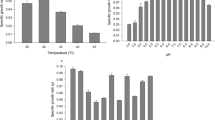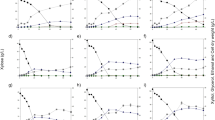Summary
The ability to convertd-xylose to xylitol was screened in 44 yeasts from five genera. All but two of the strains produced some xylitol with varying rates and yields. The best xylitol producers were localized largely in the speciesCandida guilliermondii andC. tropicalis. Factors affecting xylitol production by a selectedC. guilliermondii strain, FTI-20037, were investigated. The results showed that xylitol yield by this strain was affected by the nitrogen source. Yield was highest at 30–35°C, and could be increased with decreasing aeration rate. Using high cell density and a defined medium under aerobic conditions, xylitol yield byC. guilliermondii FTI-20037 from 104 g/ld-xylose was found to be 77.2 g/l. This represented a yield of 81% of the theoretical value, which was computed to be 0.9 mol xylitol per mold-xylose.
Similar content being viewed by others
References
Baillargeon, M.W., N.B. Jansen, C.-S. Gong and G.T. Tsao. 1983. Effect of oxygen uptake rate on ethanol production by a xylose-fermenting yeast mutant,Candida sp XF217. Biotechnol. Lett. 5: 339–344.
Bruinenberg, P.M., P.H.M. de Bot, J.P. van Dijken and W.A. Scheffers. 1984. NADH-linked aldose reductase: the key to anaerobic alcoholic fermentation of xylose by yeasts. Appl. Microbiol. Biotechnol. 19: 256–269.
Bruinenberg, P.M., R. Jonker. J.P. van Dijken and W.A. Scheffers. 1985. Utilization of formate as an additional energy source by glucose-limited chemostat cultures ofCandida utilis CBS 621 andSaccharomyces cerevisiae CBS 8066. Evidence for the absence of transhydrogenase activity in yeasts. Arch. Microbiol. 142: 302–306.
Bruinenberg, P.M., J.P. van Dijken and W.A. Scheffers. 1983. A theoretical analysis of NADPH production and consumption in yeasts. J. Gen. Microbiol. 129: 953–964.
Chen, L.F. and C.S. Gong. 1985. Fermentation of sugarcane bagasse hemicellulose hydrolysate to xylitol by a hydrolysate-acclimatized yeast. J. Food Sci. 50: 226–228.
Chung, I.S. and Y.Y. Lee. 1986. Effect of oxygen and redox potential ond-xylose fermentation by non-growing cells ofPachysolen tannophilus. Enzyme Microb. Technol. 8: 503–507.
Culbert, S.J. and Y.-M. Wang. 1986. Oral xylitol in American adults. Nutr. Res. 6: 913–922.
Emodi, A. 1978. Xylitol: its properties and food applications. Food Technol. January: 28–32.
Gong, C.-S., L.F. Chen and G.T. Tsao. 1981. Quantitative production of xylitol fromd-xylose by a high-xylitol producing yeast mutantCandida tropicalis HXP 2. Biotechnol. Lett. 3: 125–130.
Gong, C.S., T.A. Claypool, L.D. McCracken, C.M. Maun, P.P. Veng and G.T. Tsao. 1983. Conversion of pentoses by yeasts. Biotechnol. Bioeng. 15: 85–102.
Horecker, B.L. 1962. pentose metabolism in yeasts, p. 29, John Wiley & Sons, Inc., New York.
Lee, H., A.L. Atkin, M.F.S. Barbosa, D.R. Dorscheid and H. Schneider. 1988. Effect of biotin limitation on the conversion of xylose to ethanol and xylitol byPachysolen tannophilus andCandida guilliermondii. Enzyme Microb. Technol. 10: 81–84.
Lee, H., P. Biely, R.K. Latta, M.F.S. Barbosa and H. Schneider. 1986. Utilization of xylan by yeasts and its conversion to ethanol byPichia stipitis strains. Appl. Environ. Microbiol. 52: 320–324.
Lee, H., A.P. James, D.M. Zahab, G. Mahmourides, R. Maleszka and H. Schneider. 1986. Mutants ofPachysolen tannophilus with improved production of ethanol fromd-xylose. Appl. Environ. Microbiol. 51: 1252–1258.
Lehninger, A.L. 1982. Principles of Biochemistry. Worth Publishers, Inc., New York.
Onishi, H. and T. Suzuki. 1966. The production of xylitol,l-arabinitol and ribitol by yeasts. Agric. Biol. Chem. 30: 1139–1144.
Onishi, H. and T. Suzuki. 1969. Microbial production of xylitol from glucose. Appl. Microbiol. 18: 1031–1035.
Slininger, P.J., P.C. Bolen and C.P. Kurtzman. 1987.Pachysolen tannophilus: properties and process considerations for ethanol production fromd-xylose. Enzyme Microb. Technol. 9: 5–15.
Wang, Y.-M. and J. van Eys. 1981. Nutritional significance of fructose and sugar alcohols. 1: 437–475.
Watson, N.E., B.A. Prior, J.C. du Preez and P.M. Lategan. 1984. Oxygen requirements ford-xylose fermentation to ethanol and polyols byPachysolen tannophilus. Enzyme Microb. Technol. 6: 447–450.
Author information
Authors and Affiliations
Additional information
Issued as NRCC publication No. 28798.
Rights and permissions
About this article
Cite this article
Barbosa, M.F.S., de Medeiros, M.B., de Mancilha, I.M. et al. Screening of yeasts for production of xylitol fromd-xylose and some factors which affect xylitol yield inCandida guilliermondii . Journal of Industrial Microbiology 3, 241–251 (1988). https://doi.org/10.1007/BF01569582
Received:
Revised:
Accepted:
Issue Date:
DOI: https://doi.org/10.1007/BF01569582




